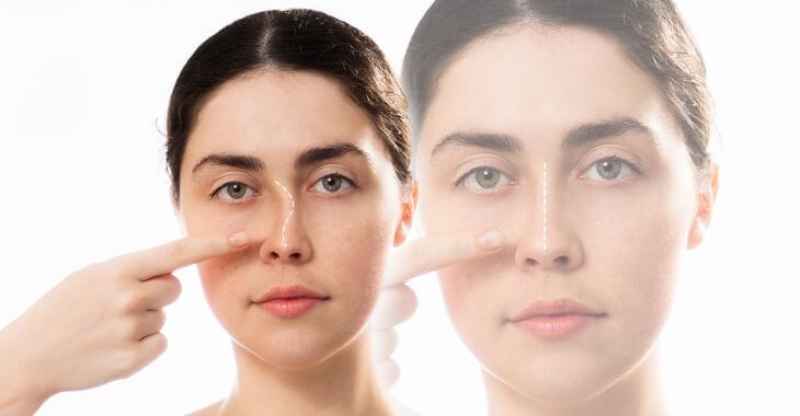If you’re considering nose surgery for health or cosmetic reasons, you’ve probably come across the terms “septoplasty” and “rhinoplasty.” Although they may seem similar, they serve different purposes. Let’s explore what sets these two surgeries apart so you can make an informed decision about your health and wellness journey.
What is a Septoplasty?
Septoplasty is a surgical procedure to correct a deviated septum, a condition in which the cartilage and bone that divide the nasal cavity (the septum) are misaligned so that one nostril is smaller than the other. This condition can lead to difficulty breathing, nasal congestion, recurrent sinus infections, and other related problems. The goal of septoplasty is to realign the septum, relieve nasal congestion, and improve overall nasal function.
Let’s explore the specifics of septoplasty, as well as its indications, surgical techniques, preoperative preparations, and what to expect during the recovery period. It is important to note that medical practices and information may change over time.
Benefits of Septoplasty
Imagine waking up every morning and breathing deeply and clearly. For many this is not the case due to deviated septum, which can have a significant impact on quality of life. Septoplasty, a surgical correction of this condition, offers many benefits beyond simple breathing. Here are some key benefits:
Improved Breathing: The main benefit of septoplasty is the significant improvement in nasal airflow, making breathing easier day and night. This can be particularly life-changing for those who have suffered from breathing difficulties for years.
Improved sleep quality: Many patients find that correcting a septal deformity results in better sleep. Problems like snoring and sleep apnea can be alleviated, resulting in more restful nights and less daytime sleepiness.
Reduction of sinus infections: A septoplasty can also reduce the frequency and severity of sinus infections by improving airflow through the nose. Good sinus drainage reduces the risk of infection and can relieve symptoms of chronic sinusitis.
Improved sense of smell and taste: Better air circulation improves the ability to smell, which can in turn improve taste. Often, patients don’t realize what they missed until after surgery.
General health benefits: Better sleep, fewer infections, and better breathing improve health. Patients may have more energy and fewer health problems due to poor respiratory function.
What is Rhinoplasty?
Rhinoplasty is a surgical procedure to reshape or adjust the internal structure of the nose. It can be performed by plastic surgeons or specialized oral and maxillofacial surgeons. It usually includes modification or remodeling of the cartilage, and rhinoplasty can change the size of the nose as well as its profile and width. The tip of the nose, the shape of the nostrils and the balance of the nose or its nasal symmetry can also be changed.
Almost all rhinoplasty processes are performed through a small incision inside the nose, which means there are no visible cuts or successive scarring on the face. In “septo-rhinoplasty,” which basically occurs in most rhinoplasty procedures, the septum (septal cartilage) along with the nasal cartilage and bones are adjusted in a single procedure. People with a deviated septum often have both difficulty breathing and a crooked nose.
However, rhinoplasty is a serious procedure that requires a lot of thought. It is especially important to consider previous nose jobs, as these can impact future rhinoplasty procedures.
Benefits of rhinoplasty
Although rhinoplasty in Turkey is often considered for its cosmetic benefits, it can also lead to functional improvements. Here is an overview of the various benefits of rhinoplasty:
Aesthetic Confidence: For many, the most important benefit is improved self-esteem. This can lead to better social interactions and greater personal satisfaction.
Functional Improvements: Rhinoplasty is not just cosmetic; It can correct structural problems that hinder breathing. For example, repairing a deviated septum or reducing the size of the turbinates can improve airflow, similar to a septoplasty.
Facial symmetry: Rhinoplasty can improve facial harmony by adjusting the size, shape, and position of the nose to better complement other facial features, creating a more balanced appearance.
Psychological and Emotional Benefits: The psychological impact of correcting perceived imperfections or long-standing insecurities must be considered. Many patients report significant improvements in their mental health and well-being.
Individualization: Rhinoplasty offers a high level of individualization, allowing patients and surgeons to work closely together to achieve the desired result while taking aesthetic and functional aspects into account.
Comparison of septoplasty and rhinoplasty
Although septoplasty and rhinoplasty may seem similar at first glance, they serve different purposes and offer unique benefits:
Purpose and Objectives: Septoplasty focuses on improving nasal function by correcting septal deviation, while rhinoplasty is often performed for cosmetic reasons but may also include functional improvements.
Procedure and Recovery: Septoplasty is generally a simple procedure that targets the septum and focuses on internal changes, often resulting in a faster recovery. Rhinoplasty can be more complex, involve changes to the bones and cartilage, and usually requires a longer recovery period due to the external changes.
Possible Results: The results of septoplasty are largely internal, with the main benefit being improved breathing. A rhinoplasty, on the other hand, can dramatically change the appearance of the nose and improve respiratory function. It depends on the extent of the procedure.
Can septoplasty and rhinoplasty be combined?
The combination of procedures can be more effective and less expensive, requiring only one operation and a recovery period. Patients can benefit from improved nasal function. And appearance, making it a comprehensive solution for people suffering from functional and cosmetic nasal problems.
However, it is imperative to consult a qualified surgeon who can assess whether this combined approach is suitable for your specific needs and goals.
It is important for anyone considering nose surgery to understand the differences between septoplasty and rhinoplasty. By carefully considering your goals and consulting with experienced professionals. You can make an informed decision that meets your health and aesthetic needs.
ALSO READ: Five Pointers for Developing a Natural Skincare Programme
ALSO READ: How Can You Choose the Right Serum for the Skin on Your Face?
